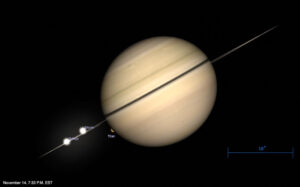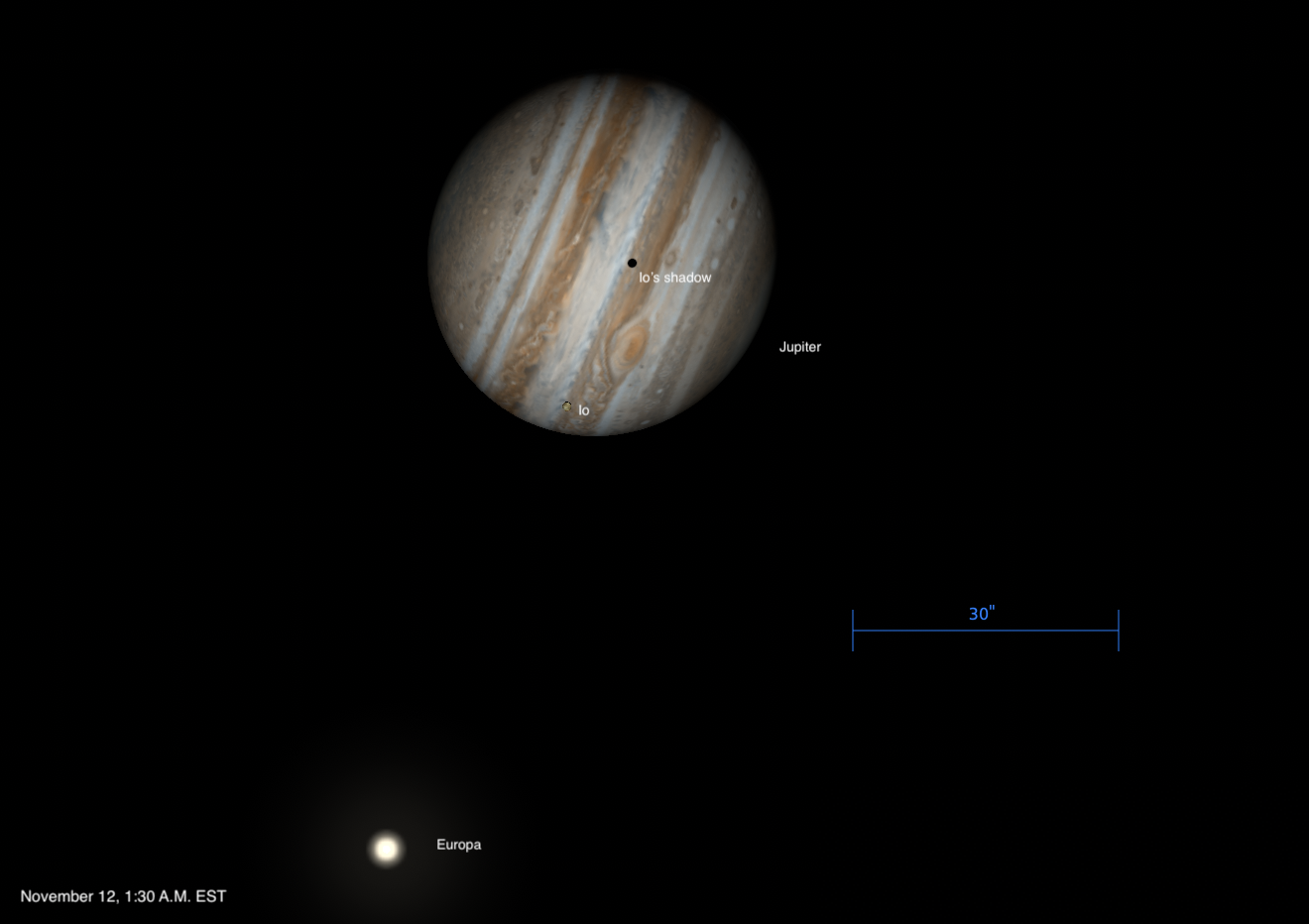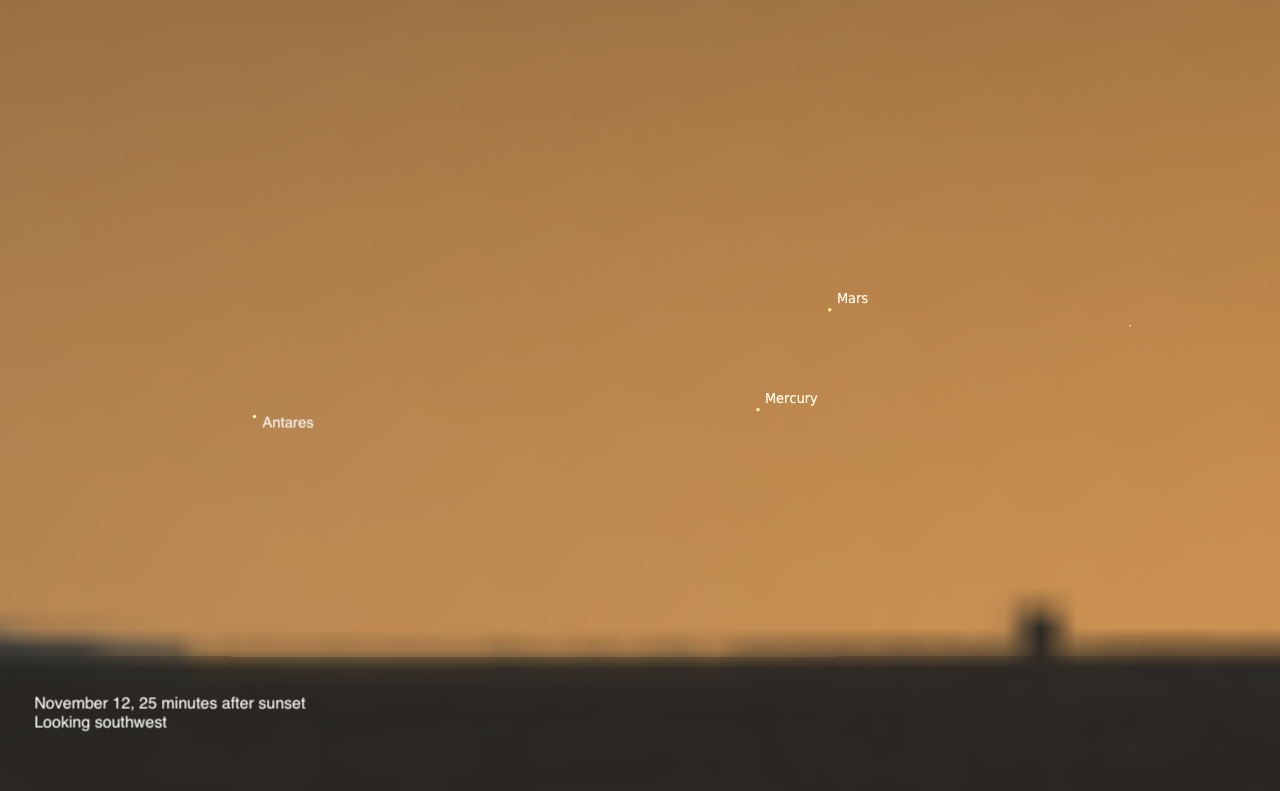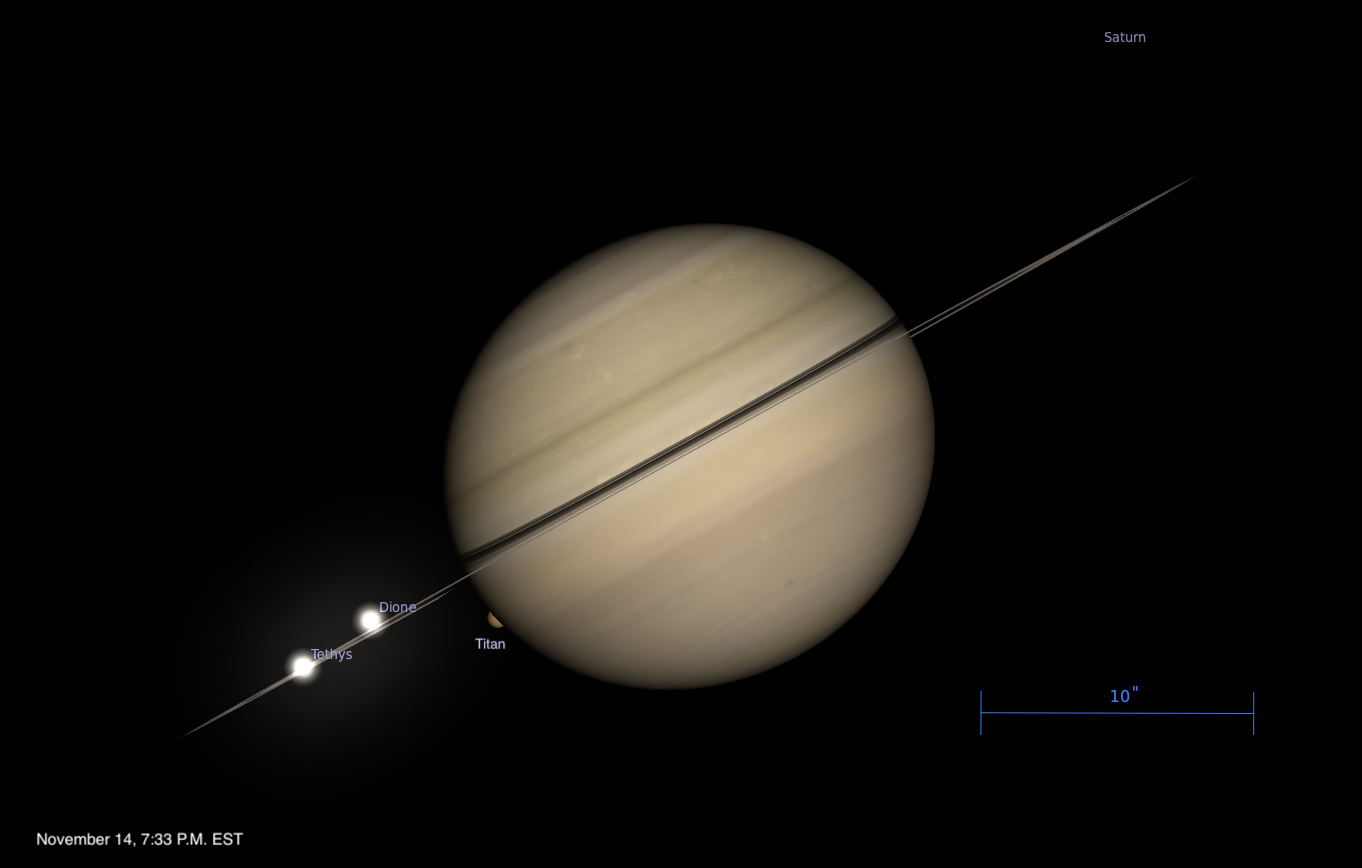Special to CosmicTribune.com, November 09, 2025
Excerpts from weekly Astronomy.com report.
Sunday, November 9
Mercury stands stationary this evening at 6 P.M. EST, bringing its easterly motion to an end. The planet will now begin moving retrograde, or westward, relative to the background stars.
Currently located near the claws of Scorpius, Mercury shines today at magnitude 0.3 and is roughly even with the red giant Antares as they set in the sky soon after sunset. You’ll need to be quick — some 30 minutes after sunset this evening, the pair is just 2.5° high in the southwest. You’ll need a clear horizon if you want to spot them, and binoculars will aid with the search. If you can center on Mercury, look 4° to the left for 1st-magnitude Antares.

Mars is also nearby, even with Mercury and located to the planet’s right above the horizon. The Red Planet is roughly the same brightness as Antares, so will also require optical aid. It will continue to grow harder to see as the days pass, quickly moving toward solar conjunction in early January. This may be one of your last chances to spot it before then.
Later tonight, the gibbous Moon rises near Jupiter around 9 P.M. local time. They are visible overnight and into tomorrow morning, offering a great target for observers regardless of whether you’re a night owl or an early bird.
Sunrise: 6:38 A.M.
Sunset: 4:48 P.M.
Moonrise: 8:42 P.M.
Moonset: 11:35 A.M.
Moon Phase: Waning gibbous (72%)
Monday, November 10
The Moon passes 4° due north of Jupiter at 3 A.M. EST. Both are visible into the early-morning hours, setting after sunrise. They are highest around 4:30 A.M. local time, when the pair reaches an altitude of 70° above the southern horizon.
Despite the bright Moon, Jupiter should be easy to find with the naked eye, glowing at magnitude –2.4. Both lie in Gemini the Twins, hanging below the constellation’s two bright stars, Castor and Pollux.
Asteroid 471 Papagena reaches opposition today at 10 A.M. EST in the constellation Cetus, also currently home to Ceres. Papagena rises tonight around 6 P.M. local time, so you can try taking advantage of the dark window before moonrise (around 10 P.M. local time) to view it. By 8:30 P.M., 9th-magnitude Papagena is 30° high in the east, near the border of Cetus and Taurus.
Sunrise: 6:40 A.M.
Sunset: 4:48 P.M.
Moonrise: 9:56 P.M.
Moonset: 12:18 P.M.
Moon Phase: Waning gibbous (61%)
 Catch Io and its shadow crossing Jupiter together late on the 11th/early on the 12th, depending on your time zone. Credit: Stellarium/James Hastings-Trew/NASA Cassini/Oleg Pluton
Catch Io and its shadow crossing Jupiter together late on the 11th/early on the 12th, depending on your time zone. Credit: Stellarium/James Hastings-Trew/NASA Cassini/Oleg PlutonTuesday, November 11
Jupiter now stands still; like Mercury, it is also halting its prograde motion in favor of turning westward. The gas giant reaches its stationary point in Gemini at 3 P.M. EST.
Rising around 9 P.M. local time, Jupiter sits to the lower right of Castor and Pollux in Gemini the Twins. By midnight, it has risen to an altitude of 30° in the east and is a prime telescope target, though note the Moon nearby may affect viewing slightly.
Io and its shadow are crossing in front of the disk this evening, with Europa following later. Io’s shadow appears at the eastern limb just after midnight in the Eastern time zone — around 12:10 A.M. EST on the 12th; note this is still late on the 11th farther west. Io itself is visible just off the eastern limb and begins its own transit a little over an hour later, around 1:20 A.M. EST (now the 12th for the eastern half of the U.S.). The shadow is gone an hour later, as Io reaches about halfway across the disk.
Sunrise: 6:41 A.M.
Sunset: 4:47 P.M.
Moonrise: 11:07 P.M.
Moonset: 12:52 P.M.
Moon Phase: Waning gibbous (51%)
 You have a short time to catch Mercury, Mars, and Antares in the southwestern sky after sunset on the 12th. Credit: Stellarium
You have a short time to catch Mercury, Mars, and Antares in the southwestern sky after sunset on the 12th. Credit: StellariumWednesday, November 12
Last Quarter Moon occurs early this morning 12:28 A.M. EST with the Moon in Leo and near the Lion’s brightest star, Regulus. Our satellite will pass 1° due north of Regulus this evening at 7 P.M. EST, though the pair won’t be visible until they rise shortly after midnight.
Mars shines at magnitude 1.4 and Mercury is now magnitude 0.8. Magnitude 1.1 Antares is now located 5° to the left of Mercury, and you can use this star as a starting point. Start looking for Antares low in the southwest about 25 minutes after sunset. It will only be 3° high. If you can center it in your binoculars, sweep to the right to land on Mercury, then slowly move 1.3° in the direction of one o’clock from Mercury’s position. That should land you on Mars. You’ll only have about 10 minutes to locate it, given how quickly the region is setting into the hazy air near the still-bright horizon. Use the chart above, and good luck!
Sunrise: 6:42 A.M.
Sunset: 4:46 P.M.
Moonrise: —
Moonset: 1:20 P.M.
Moon Phase: Waning crescent (40%)
Thursday, November 13
The Moon now lies to the lower left (east) of Regulus in Leo as they rise early this morning in the east shortly after midnight. By 5 A.M. local time, they’ve reached 50° high in the southeast. The Moon appears sandwiched between the Lion’s two brightest stars: Regulus, the Lion’s heart; and Denebola, the Lion’s tail.
Now a 38-percent-lit crescent, the Moon shows off its western limb, while sunset has darkened the rest of the lunar nearside. Visible just beyond the edge of the terminator dividing night and day is the round, well-defined crater Copernicus in the lunar northwest. Some 56 miles (90 kilometers) across, Copernicus’ eastern rim should appear brighter than its western side as the Sun sets over the landscape, illuminating it from the west. The normally easy-to-identify bright rays of ejecta that surround the crater are now muted, but still visible as you scan the area with a telescope.
To Copernicus’ southeast is much smaller Kepler, only about 20 miles (32 km) wide. Its rays should be slightly more visible, overlapping with those of Copernicus in the region between the two craters.
Sunrise: 6:43 A.M.
Sunset: 4:45 P.M.
Moonrise: 12:14 A.M.
Moonset: 1:43 P.M.
Moon Phase: Waning crescent (31%)
 By just after 7:30 P.M. EST, Titan is beginning to peek out from behind Saturn’s southeastern limb. It will take several minutes for the large moon to fully emerge from behind the planet. Credit: Oleg Pluton
By just after 7:30 P.M. EST, Titan is beginning to peek out from behind Saturn’s southeastern limb. It will take several minutes for the large moon to fully emerge from behind the planet. Credit: Oleg PlutonFriday, November 14
Titan is hidden by Saturn for the first part of the evening in the eastern U.S., emerging from occultation behind the ringed planet’s disk beginning at 7:26 p.m. EST. This occurs in twilight for the Mountain time zone, but in darkness farther east.
If you’re able to catch the event, plan to get your telescope set up and ready well ahead of time. First-magnitude Saturn rises before sunset and is already 40° high in the south by 7 P.M. local time (note this is after the event begins in the Central time zone). It’s located in far northeastern Aquarius and is the brightest point of light in this part of the sky, to the upper left of slightly fainter magnitude 1.2 Fomalhaut.
Titan begins to appear at 7:26 P.M. EST, taking several minutes to make its way into view. Also visible to Saturn’s east before Titan begins to emerge are 10th-magnitude Dione and Tethys; the former is closer to the planet. Both are close to the rings and begin transits shortly after Titan emerges, although they will be too faint to see by eye against the brightness of Saturn’s disk. Experienced imagers using high-speed video cameras may catch them. Tenth-magnitude Rhea is far to Saturn’s east; see if you can spot this moon as well.
Several more moons are visible but are fainter and may not appear in all telescopes. You can use a planetarium program of your choosing to identify any you think you might see.
Sunrise: 6:44 A.M.
Sunset: 4:44 P.M.
Moonrise: 1:19 A.M.
Moonset: 2:03 P.M.
Moon Phase: Waning crescent (22%)

You must be logged in to post a comment Login